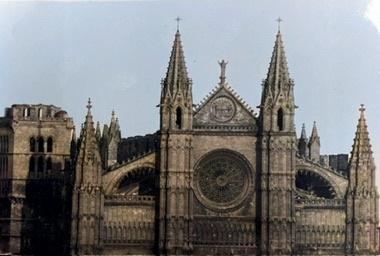How does the Rose Window in the Cathedral of Palma compare to other stained glass windows in Europe?
Similar Topics
rose window palma
cathedral of palma
gothic stained glass
mediterranean influence
european rose windows
stained glass artistry
palma la seu
gothic cathedral windows
The Rose Window in the Cathedral of Palma, also known as La Seu, stands as a striking example of Gothic stained glass artistry in Spain, and it holds a distinctive place among Europe's renowned cathedral windows. Completed in the early 14th century, this impressive circular window spans over 12 meters in diameter, making it one of the largest rose windows in Europe. Its design features intricate tracery and vibrant hues of blue, red, and yellow, which flood the cathedral's interior with a kaleidoscope of color, especially during the afternoon when the sunlight aligns with the window’s orientation. This dynamic play of light enhances the spiritual atmosphere, creating a contemplative space for visitors and worshippers alike.
Compared to other famous rose windows, such as those found in the cathedrals of Chartres, Notre-Dame de Paris, and Sainte-Chapelle, the Palma Rose Window is notable for its unique Mediterranean influence and its integration with the cathedral’s coastal setting. While the French examples often emphasize biblical scenes and figures in a more rigid, medieval narrative style, La Seu’s rose window tends toward a more abstract, floral-inspired pattern that highlights geometric harmony and vibrant chromatic effects rather than storytelling. This difference reflects regional artistic tendencies and the broader Gothic architectural trends present in the Balearic Islands during the period.
Moreover, the Cathedral of Palma's rose window has the particular distinction of being part of a larger architectural and artistic dialogue. Its striking colors contrast beautifully with the bright sandstone facade of the cathedral, and it works in concert with another window—the large northwest rose—to frame the cathedral’s towering interior space. This interplay of light and space is somewhat distinct from northern European cathedrals, where sometimes multiple, more elaborate figurative windows line the interiors. The Palma window’s effect is perhaps more singular and meditative, offering a window into the Mediterranean Gothic style that both aligns with and diverges from the grand stained glass traditions of northern Europe.
In summary, the Rose Window of the Cathedral of Palma is a masterful blend of Gothic design and local artistic sensibilities that sets it apart from other European stained glass masterpieces. It is less about elaborate biblical narratives and more about the ethereal beauty of colored light and pattern, which gives the visitor a uniquely contemplative experience reflective of the cathedral’s sun-drenched island environment. This contrast enriches the broader European heritage of stained glass, making the Palma Rose Window a must-see for travelers and art lovers interested in the varied expressions of Gothic ecclesiastical art.
Compared to other famous rose windows, such as those found in the cathedrals of Chartres, Notre-Dame de Paris, and Sainte-Chapelle, the Palma Rose Window is notable for its unique Mediterranean influence and its integration with the cathedral’s coastal setting. While the French examples often emphasize biblical scenes and figures in a more rigid, medieval narrative style, La Seu’s rose window tends toward a more abstract, floral-inspired pattern that highlights geometric harmony and vibrant chromatic effects rather than storytelling. This difference reflects regional artistic tendencies and the broader Gothic architectural trends present in the Balearic Islands during the period.
Moreover, the Cathedral of Palma's rose window has the particular distinction of being part of a larger architectural and artistic dialogue. Its striking colors contrast beautifully with the bright sandstone facade of the cathedral, and it works in concert with another window—the large northwest rose—to frame the cathedral’s towering interior space. This interplay of light and space is somewhat distinct from northern European cathedrals, where sometimes multiple, more elaborate figurative windows line the interiors. The Palma window’s effect is perhaps more singular and meditative, offering a window into the Mediterranean Gothic style that both aligns with and diverges from the grand stained glass traditions of northern Europe.
In summary, the Rose Window of the Cathedral of Palma is a masterful blend of Gothic design and local artistic sensibilities that sets it apart from other European stained glass masterpieces. It is less about elaborate biblical narratives and more about the ethereal beauty of colored light and pattern, which gives the visitor a uniquely contemplative experience reflective of the cathedral’s sun-drenched island environment. This contrast enriches the broader European heritage of stained glass, making the Palma Rose Window a must-see for travelers and art lovers interested in the varied expressions of Gothic ecclesiastical art.
🧩 Related Questions
Related Question
What challenges do educators face when balancing Catalan and Spanish language instruction in Mallorca?
Related Question
How is carob processing integrated into Mallorca’s shift towards sustainable food production?
Related Question
What role does the fiber in almonds play in promoting cardiovascular health?
